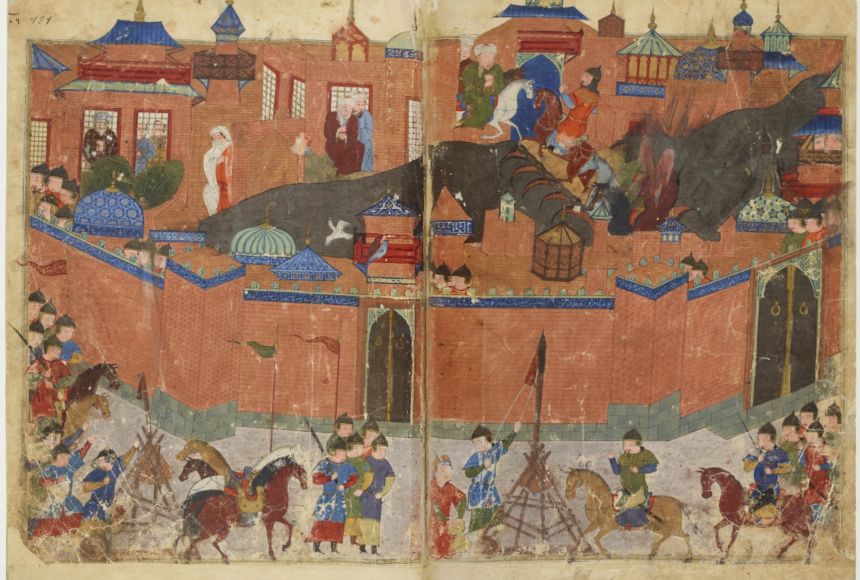The Mongol Horde was a largely undefeated fighting force. They conquered China. They terrorized Eastern Europe, sacked Baghdad, and attacked the Mamluks in Egypt.
The name Mongol Horde sounds like a giant swarming army that destroyed other armies by having more fighters. But the Mongol word "horde" really means something like military camp or headquarters. The Mongols did win battles because of their superior horse riding. They also won them with special compound bows that were made of several pieces of wood, animal horn, and tendons glued together. These bows could shoot farther than most other bows.
The Mongols were also very skilled at surrounding cities. Then they laid siege to them. During sieges, the Mongols used technology they got from the Chinese. Some of these were gunpowder bombs, canons, and catapults.
Mongol Conquest of China
The Great Wall of China was built to keep away northern forces. However, in the 13th century, the wall provided little defense.
The Mongol invasion of China started in 1211. Genghis Khan's forces took on the northern Chinese Jin Empire. At this time, China was divided into the Song Empire in the south and the Jin Empire in the north. The Mongols took advantage of the division. Genghis Khan allied his forces with defectors from the Jin state in order to overtake their army. The Jin state became part of the Mongol Empire under Ogodei Khan in 1234.
Kublai Khan was the grandson of Genghis Khan. He began a second invasion of China. Mongol forces overtook the Song's city of Xianyang. The last Song emperor fled and died in 1279. This marked the complete takeover of China by Mongol rulers. Kublai Khan became the first emperor of the Yuan Dynasty. It lasted until 1368. It was the first non-Chinese dynasty to rule all of China. Under the rule of Kublai Khan, the Mongol Empire became the largest contiguous, or connected, empire ever seen.
Mongols Go West
Conquering China was a major victory. However, it was just the beginning. In the 1230s, the Mongols began eyeing territory in Eastern Europe. Batu, another grandson of Genghis Khan, expanded Mongol rule to modern-day western Russia and Ukraine. In the east, Batu extended Mongol territory to Siberia. The Mongol army sacked the city of Kiev in Ukraine in 1240. Forces marched toward Hungary and Poland. They defeated the Hungarian and Polish armies. The Hungarian king fled.
However, by 1242, the Mongol forces turned back without overtaking Hungary. The reasons for this retreat are largely unknown. Scholars have a few ideas. Some have suggested it was the death of the Great Khan Ogodei. The army returned to Mongolia in order to choose a new ruler. However, some researchers have proposed a new theory. Unusual cold and snow may have helped the Mongols cross the frozen Danube River in the winter. However, the spring weather was not so forgiving. That particular spring was unusually wet. Wet and muddy conditions would have limited where the horses could graze.
The Sack of Baghdad
Mongol forces sacked Baghdad, the jewel of the Abbasid Caliphate, in 1258. Under the direction of Hulegu Khan, still another grandson of Genghis Khan, the Mongols defeated Muslim forces in modern-day Iran, Iraq, and Syria. Hulegu came to control all of Iran. He founded the Il-khan Dynasty. (Il-khan means subordinate khan in Persian.)
The sack of Baghdad began in 1258. Hulegu sent a letter to the caliph of Baghdad demanding control of the city. He threatened to destroy everything should he not receive it. The caliph, Mustasim, did not take Hulegu's threat seriously. He did little to properly defend the city.
The Mongols destroyed Baghdad. They threw all the books from the libraries of Baghdad into the Tigris River.
Mongol Defeat at Ain Jalut
The Mamluks were an enslaved army loyal to the various Islamic state rulers. While they technically were enslaved, Mamluks could hold high status in Islamic society. At some points in history, members of the Mamluks were even installed as sultans over Egypt and Syria. As a fighting force, the Mamluks were well-equipped, elite warriors. Much like the Mongols, the Mamluks were especially skilled horsemen. They rode Arabian horses. They are much larger than the short, sturdy breeds used by the Mongols. Mamluks spent their whole lives in intensive training for all forms of combat: horseback archery as well as close-quarter combat with swords, lances, and clubs.
The Mongols, under Hulegu, marched on Egypt after they conquered Syria in 1260. Hulegu sent a threatening letter to the Mamluk Sultan Qutuz before sending an army. However, Hulegu's brother, Mongke, who was Great Khan at the time, had died. Hulegu had to return to Mongolia so a new leader could be chosen. He left an army of 20,000 under his general, Ketbugha.
At Ain Jalut in Gaza, the Mamluks took advantage of Hulegu's absence. They marched on this smaller Mongol army. The Mamluks used ambush tactics and hand cannons to frighten the Mongol horses. The Mongols and the Mamluks both suffered significant losses. However, the Mamluks managed to kill almost the entire Mongol Horde, including General Ketbugha. This defeat forced the Mongols back to Iran and solidified the western Mongol border. The battle of Ain Jalut is important because it was the Mongols' first significant defeat.

